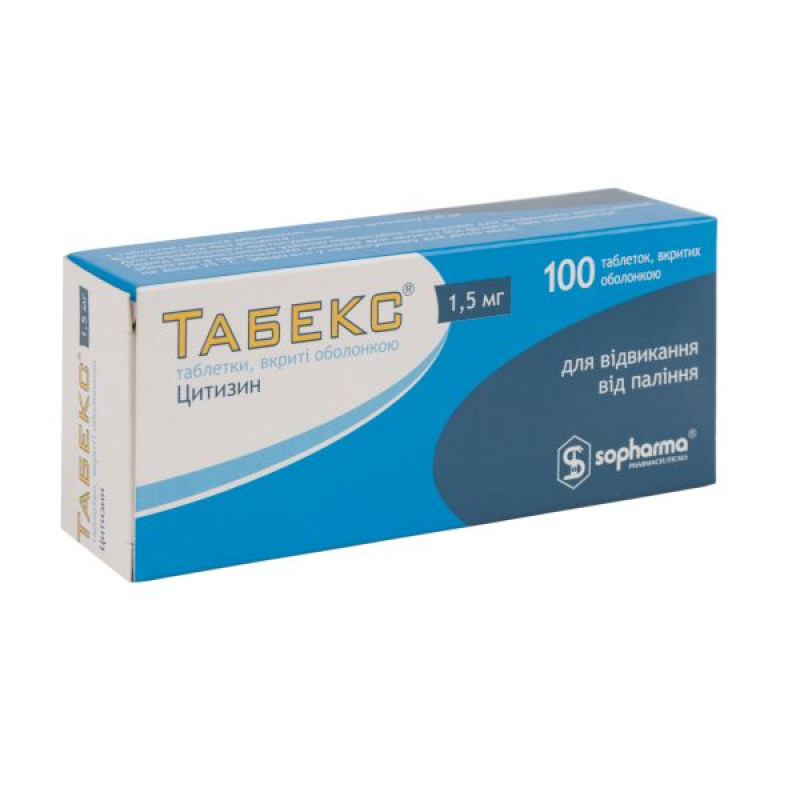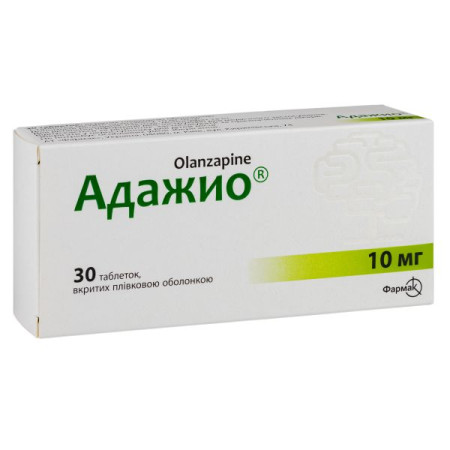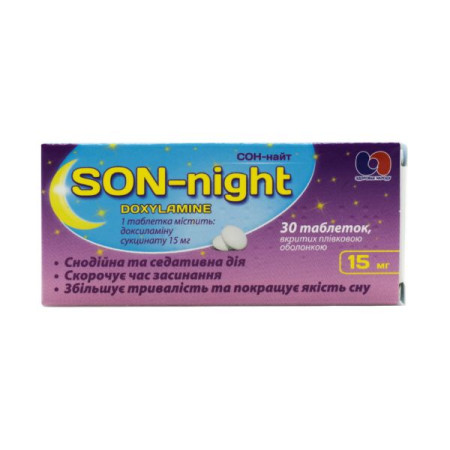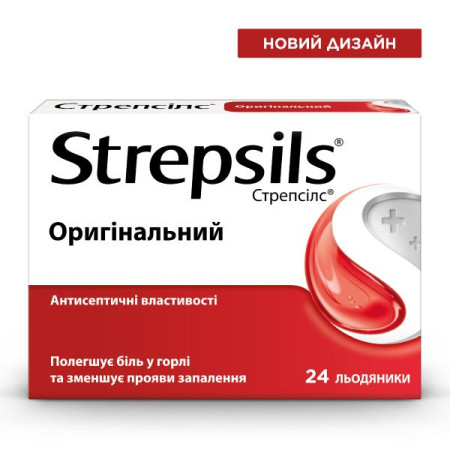Tabex film-coated tablets 1.5 mg No. 100

Instructions Tabex film-coated tablets 1.5 mg No. 100
Composition
active ingredient: cytisine;
1 film-coated tablet contains 1.5 mg of cytisine;
excipients: powdered cellulose, calcium sulfate dihydrate, colloidal anhydrous silicon dioxide, magnesium stearate;
film coating: Opadry II brown 85G 265001 [partially hydrolyzed polyvinyl alcohol, titanium dioxide (E 171), macrogol 4000, lecithin, talc, iron oxide yellow (E 172), iron oxide red (E 172), iron oxide black (E 172)].
Dosage form
Film-coated tablets.
Main physicochemical properties: round biconvex, film-coated tablets, 5.5 mm in diameter, engraved with S on one side of the tablet, beige in color.
Pharmacotherapeutic group
Medicinal products used for nicotine addiction. ATX code N07B A04.
Pharmacological properties
Pharmacodynamics
The effect of the drug is to excite the ganglia of the autonomic nervous system, to stimulate reflex respiration, to release adrenaline from the medullary part of the adrenal glands, to increase blood pressure. The mechanism of action of cytisine is close to the mechanism of action of nicotine, but with much less toxicity and greater therapeutic effect. Cytisine competitively inhibits the interaction of nicotine with the corresponding receptors, which leads to a gradual decrease and disappearance of nicotine dependence.
Pharmacokinetics
Absorption: Cytisine is rapidly absorbed from the gastrointestinal tract after oral administration. Maximum plasma concentration of 15.55 ng/ml is reached within 0.92 hours.
Distribution: There are no data on the volume of distribution in humans.
Biotransformation and excretion: Cytisine is not metabolized in the body. Up to 64% of the administered dose is excreted unchanged in the urine within 24 hours. The half-life is approximately 4 hours. The average retention time of cytisine in the body is approximately 6 hours.
Indication
For chronic nicotine addiction – to help quit smoking.
Contraindication
Hypersensitivity to the active substance or to any of the excipients, acute myocardial infarction, unstable angina, cardiac arrhythmia, recent cerebrovascular disease, atherosclerosis, severe arterial hypertension, pregnancy and breastfeeding.
Interaction with other medicinal products and other types of interactions
Increased CYP1A2 activity is observed in smoking. After smoking cessation, the activity of this isoenzyme may decrease, which may lead to increased plasma concentrations of drugs metabolized by CYP1A2, such as theophylline, ropinirole, clozapine and olanzapine. In these cases, their side effects may be increased, since these drugs have a narrow therapeutic index.
With simultaneous use of Tabex with cholinomimetics and anticholinesterase drugs, increased cholinomimetic side effects are possible.
Concomitant use with antihyperlipidemic drugs (statins) increases the risk of myalgia.
Simultaneous use of Tabex with antihypertensive drugs may weaken their effect.
Application features
Tabex should only be used if the patient is serious about quitting smoking. Taking the drug and smoking at the same time can lead to increased side effects of nicotine (nicotine intoxication).
There is insufficient clinical experience with the use of Tabex in patients with ischemic heart disease, heart failure, arterial hypertension, cerebrovascular disease, obliterating arterial disease, hyperthyroidism, peptic ulcer, diabetes mellitus, renal or hepatic insufficiency. The drug should be prescribed to these categories of patients only after a careful assessment of the benefit/risk ratio by the doctor.
Due to the lack of adequate safety studies, the use of the drug in patients with some forms of schizophrenia, patients with adrenal chromaffin tumors and gastroesophageal reflux disease is possible only after a careful assessment of the benefit/risk ratio.
There is insufficient clinical experience regarding the safe use of Tabex in children (under 18 years of age) and the elderly (over 65 years of age), therefore its use is not recommended in these age groups.
Ability to influence reaction speed when driving vehicles or other mechanisms
The use of Tabex usually does not affect the reaction speed when driving or working with other mechanisms.
Considering that sensitive patients may occasionally experience adverse reactions (drowsiness, dizziness) while taking the drug, at the beginning of treatment you should refrain from driving vehicles or working with other mechanisms.
Use during pregnancy or breastfeeding
The use of the drug is contraindicated during pregnancy or breastfeeding.
Method of administration and doses
The drug should be used according to the following scheme: from the 1st to the 3rd day - 1 tablet every 2 hours (6 tablets per day). At the same time, gradually reduce the number of cigarettes smoked. If the result is unsatisfactory, the treatment is stopped and can be resumed after 2-3 months. If the effect is positive, continue the treatment according to the following scheme:
from the 4th to the 12th day – 1 tablet every 2.5 hours (5 tablets per day); from the 13th to the 16th day – 1 tablet every 3 hours (4 tablets per day); from the 17th to the 20th day – 1 tablet every 5 hours (3 tablets per day); from the 21st to the 25th day – 1-2 tablets per day.
Take the tablets whole, with sufficient liquid.
Final cessation of smoking should occur by the fifth day after the start of treatment. After completing the course of treatment, the patient should show willpower and not allow himself to smoke a single cigarette.
Duration of treatment (according to the scheme).
Patients aged 65 years and over
The drug is not recommended for use in this age group of patients.
Children
Do not use on children.
Overdose
Symptoms of overdose: nausea, vomiting, profuse sweating, tremor, visual disturbances, general weakness, tachycardia, clonic convulsions, respiratory paralysis.
Treatment: gastric lavage; if the patient is conscious, intravenous administration of water-salt solutions; use of anticonvulsants, cardiotonics, analeptics and other symptomatic agents. Monitor breathing, blood pressure and heart rate.
Adverse reactions
The drug is usually well tolerated. Mild to moderate side effects are rare. Most of them occur at the beginning of treatment and disappear during treatment. Most often they are associated with quitting smoking and are manifested by dizziness, headache and insomnia.
On the part of the endocrine system: increased sweating, weight loss.
From the nervous system: headache, dizziness, insomnia, drowsiness, increased irritability.
Cardiac: tachycardia, palpitations.
Vascular: slight increase in blood pressure.
Respiratory, thoracic and mediastinal disorders: dyspnea.
Gastrointestinal: changes in taste and appetite, dry mouth, abdominal pain, nausea, constipation, diarrhea, upper abdominal pain, dyspepsia, vomiting.
Musculoskeletal and connective tissue disorders: myalgia.
General disorders: chest pain.
Expiration date
2 years.
Storage conditions
Keep out of reach of children.
Store in the original packaging to protect from moisture, at a temperature not exceeding 25 °C.
Packaging
20 film-coated tablets in a blister of PVC/PE/PVDC film and aluminum foil. 5 blisters in a cardboard box.
Vacation category
Without a prescription.
Producer
JSC "VITAMINS".
Location of the manufacturer and its business address
Ukraine, 20300, Cherkasy region, Uman city, Uspenska st., 31.
There are no reviews for this product.
There are no reviews for this product, be the first to leave your review.
No questions about this product, be the first and ask your question.















